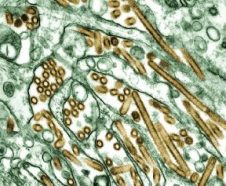Flu Patrol
Scientists are preparing for a possible flu epidemic.
By Emily Sohn
Each winter, the flu makes its rounds, jumping from victim to victim at schools and in offices. Miserable kids and adults stay at home in bed or go to the hospital with fevers, sniffles, sore throats, muscle aches, and coughs.
Just as the flu spreads among people, so, too, does fear of what the flu can do.
The flu is short for influenza, a disease caused by certain microbes called viruses. Although it shares symptoms with the common cold, influenza is a more serious disease. People are afraid of it because it’s unpredictable and can be deadly.
 |
|
Although both the common cold and the flu share symptoms, such as a runny nose, coughing and sneezing, and fever, the flu is a more serious disease. |
| CDC, Public Health Image Library |
In any given year, influenza can kill as many as 500,000 people around the world. Some years, though, major outbreaks erupt without warning. In 1918, for example, influenza killed more than 20 million people. The years 1957 and 1968 were bad, too.
Now, many experts say that we are overdue for the next deadly strain of flu virus to strike. Recent news reports from Southeast Asia and Eastern Europe have been fueling that fear. There, a persistent strain of influenza is spreading among birds and sometimes jumping from birds to people. With time, the virus might start a worldwide epidemic (or pandemic).
This thought can be scary but, for now, there’s no need to barricade yourself in the basement with a stockpile of water and a winter’s supply of canned food, says Bill Schaffner. He’s an infectious disease expert at Vanderbilt University in Nashville, Tenn.
“This is not terrifying,” Schaffner says. Instead, he suggests, look at the flu as part of a scientific detective story.
Infectious diseases
In recent decades, scientists have virtually rid the world of some infectious diseases, including measles and polio. The flu, however, has been more stubborn.
Like other viruses, the virus that causes influenza is a miniscule shell of proteins and fats that surrounds pieces of the genetic material DNA. Viruses aren’t really alive, but they attack living cells. Once a virus has injected its DNA into a host cell, it multiplies into more viruses that go on to invade more cells.
A virus’s DNA directs the production of proteins that sit on its surface. When a virus attacks your body for the first time, it can wreak havoc on your unprepared immune system. Once your cells learn to recognize those proteins, however, you become less likely to get sick if the virus comes around again.
 |
|
Scientists can create flu shots that help our bodies fight off certain flu viruses. |
| CDC, Public Health Image Library |
The problem with the influenza virus is that it’s constantly changing. Every year, small and random mutations in the flu’s DNA give it new power to make us sick again. Luckily, the changes are usually small enough that our bodies can recognize parts of the virus and eventually fight it off. Scientists can also predict these changes and create flu shots that help protect us.
It’s when something causes DNA inside an influenza virus to change dramatically that big trouble erupts. The virus then becomes so foreign to our immune systems that we are powerless against it.
Bird flu
Variations of the flu circulate among most species of birds and mammals, and different strains usually stay within different animals. In 1957, 1968, and also, recent studies show, in 1918, the strains of influenza that caused so much trouble began as a bird flu, or avian influenza, which suddenly mutated enough to infect people.
 |
|
To study what made the virus that caused the 1918 flu epidemic so deadly and develop new vaccines, scientists have recreated this virus in the laboratory. |
| James Gathany, CDC, Public Health Image Library |
Could the same thing happen with today’s Asian bird flu virus, called H5N1? So far, it has infected 135 people, of whom 69 died.
“On rare occasions, and I can’t emphasize the ‘rare’ enough, human beings who have very close associations with affected poultry can get this bird flu,” Schaffner says. “But the virus has not developed the capacity to go from person to person. A genetic change needs to happen before it becomes a threat to the human population. That has not happened yet.”
Influenza epidemics are like hurricanes. They’re impossible to prevent, but being prepared can go a long way. “The trick,” Schaffner says, “will be to minimize damage and to respond quickly.”
With these goals in mind, experts around the world are testing birds and monitoring flu patients for evidence of infection with H5N1. They use the Internet to share information.
“This type of international collaboration is better than it ever used to be,” Schaffner says. Communication is also faster than ever before.
 |
|
This colorized image shows the influenza virus H5N1 (gold) grown among kidney cells (green). |
| Cynthia Goldsmith, CDC, Public Health Image Library |
Scientists have already figured out the exact sequence of molecular pieces that make up the DNA of H5N1. Analyses have even turned up critical similarities between this strain and the 1918 version. Tests are now underway on a vaccine that would give people small doses of the virus so that their immune systems could learn how to beat it.
“Every week that goes by, we’re a little more ready,” Schaffner says.
Uncovering mysteries
A cure for the flu, however, remains a long way off, and there will be plenty of opportunities to uncover its mysteries for years to come.
“This is the kind of story I like to tell middle school students to get them interested in being physicians and public health people,” he says. “It combines science and international cooperation. It melds the exotic with what could happen elsewhere in the world. It calls into play the careful use of the mind and scientific techniques at the lab bench that relate to how we can protect our own community and people around the world.”
For now, Schaffner has some advice. “Don’t be scared. Remain alert. Hurry up and come join us,” he says. “We need those middle schoolers to become influenza scientists and help us lick the flu.”
Until then, keep your immune system healthy by sleeping enough and eating well. Get a flu shot. And wash your hands regularly. It’s one of the most effective ways to keep viruses at bay.
Going Deeper:







